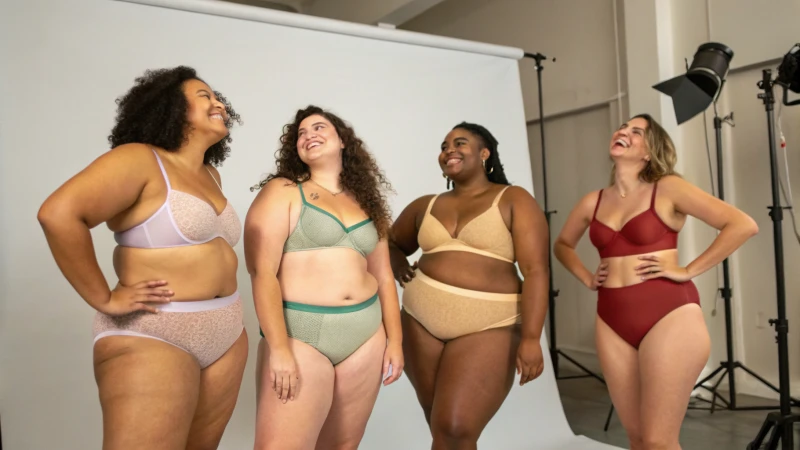%[Flat lay of assorted custom underwear pieces on a textured surface](https://xiweiundies.com/wp-content/uploads/2024/12/屏幕截图-2024-11-23-194640-png.avif"Assorted Custom Underwear")
Ever wondered how to take your custom underwear sales to the next level? Co-branding might just be the game-changer you need.
Co-branding can significantly boost custom underwear sales by leveraging the brand equity of multiple partners. This collaboration increases product visibility, builds customer trust, and creates exclusivity, driving sales through joint marketing and cross-promotion strategies.
I remember the first time I stumbled upon a co-branded product; it was like finding a hidden treasure that connected two worlds I loved. Imagine pairing your custom underwear line with a top fitness brand—instantly, you're not just selling underwear but a lifestyle. By teaming up with brands that align with your values, you tap into their customer base, enhancing visibility and credibility. It’s like getting a personal introduction to a whole new crowd eager to discover what makes your brand special. This synergy not only saves on marketing costs but also amplifies your reach, making it a win-win for both parties involved.
Co-branding increases product visibility for custom underwear.True
Co-branding leverages multiple brands, enhancing visibility and reach.
Co-branding guarantees immediate sales increase in all markets.False
Success depends on market fit and execution, not guaranteed everywhere.
How Can Co-Branding Transform Custom Underwear Brands?
Ever wondered how partnering with another brand could transform your custom underwear line into a household name?
Co-branding empowers custom underwear brands to extend their market reach, boost credibility, and increase product visibility. This strategy opens doors to new customer segments, enables joint marketing initiatives, and facilitates cost-sharing, effectively driving sales and brand growth.

Expanding Reach and Visibility
I remember when I first teamed up with a well-known brand for my custom underwear line. It felt like stepping onto a much bigger stage. Suddenly, my designs weren't just seen by my usual customers but were reaching audiences I had never tapped into before. Co-branding gives you that leg up—access to the partner's audience1 that can skyrocket your market presence, making your brand more visible across different channels.
Building Credibility and Trust
Think about it—when you see two reputable brands joining forces, doesn't it make you trust their products a little more? That's exactly what happened when I partnered with a brand that my target customers already knew and loved. The credibility boost was significant, and I saw firsthand how this trust translated into sales for my emerging underwear brand.
Leveraging Joint Marketing Efforts
Pooling resources for marketing was a game-changer for me. Imagine being able to afford advertising campaigns you only dreamed of before! By sharing costs and efforts, both brands can amplify their reach and impact. We even hosted a co-branded event that turned out to be a huge hit—our combined marketing power was truly something else.
| Co-Branding Benefits | Description |
|---|---|
| Expanded Reach | Access to broader audiences through partner brands. |
| Enhanced Credibility | Builds trust by association with reputable brands. |
| Joint Marketing | Cost-sharing in marketing for more significant impact. |
Creating Unique Product Offerings
One of the most exciting parts of co-branding was designing unique product lines. We blended elements from both brands to create something truly special. Not only did this make our products stand out in the market, but it also attracted customers eager for exclusive, limited-edition items.
Cross-Promotion Opportunities
Cross-promotion was like having a secret weapon. By highlighting each other's products on our platforms, we introduced our brands to entirely new customer bases. It's amazing how this strategy not only increased our exposure but also fostered engagement and growth.
Sharing Risks and Costs
Every entrepreneur knows how nerve-wracking financial risks can be. Co-branding allowed me to share these burdens with my partner brand. It was particularly advantageous as we explored innovative ideas without stretching our budget too thin.
Explore more on branding strategies2 to discover how co-branding can be customized to suit your specific business goals.
Co-branding expands market reach for underwear brands.True
Partnering with established brands provides access to broader audiences.
Co-branding increases production costs for custom underwear.False
It often involves cost-sharing, reducing financial burdens for both parties.
How Can Custom Underwear Brands Choose the Right Co-Branding Partners?
Ever wonder how a simple partnership can skyrocket your custom underwear brand's success?
Custom underwear brands should choose co-branding partners that share similar values, target audiences, and offer complementary products or services. This synergy ensures mutual benefits and maximizes the potential of the collaboration.

Understand Your Brand Identity
Before diving into potential partnerships, it's crucial to have a clear grasp of your brand's identity. Reflecting on my journey, I spent countless nights defining my core values3 and what made my brand unique. This clarity not only guided my decisions but also helped me find partners who genuinely shared my vision.
Identify Complementary Sectors
I've always believed in the power of collaboration. For instance, pairing up with a fitness brand opened doors to health-conscious consumers I hadn't reached before. It's about finding sectors that naturally complement your brand, like sustainable fashion for eco-conscious clientele.
| Sector | Potential Benefits |
|---|---|
| Fitness | Access to fitness enthusiasts |
| Lifestyle | Broader audience reach |
| Eco-friendly | Appeal to sustainable fashion consumers |
Evaluate Partner Reputation
In one of my early partnerships, I learned the hard way about the importance of reputation. It's essential to research potential partners thoroughly. The last thing you want is a partner whose negative publicity4 could harm your brand's image.
Assess Audience Overlap
Understanding audience demographics5 was another eye-opener for me. By analyzing overlaps with potential partners' audiences, I could better gauge whether our collaboration would resonate with more people or simply fall flat.
Explore Joint Marketing Opportunities
Co-branding is like combining two superpowers. Imagine the creative marketing strategies you can employ! From cross-promotions to co-hosted events, these partnerships can significantly enhance engagement and visibility.
Leverage Co-Branding Success Stories
Looking at iconic partnerships, like Nike and Apple's, gave me inspiration and insights into what makes co-branding successful. These stories offer blueprints for amplifying reach and influence, guiding me in crafting my partnerships.
Custom underwear brands should partner with fitness brands.True
Fitness brands offer access to health-conscious consumers, aligning well.
Partnering with a brand with negative publicity is beneficial.False
Negative publicity can harm the reputation of custom underwear brands.
What Successful Co-Branding Examples Exist in the Fashion Industry?
Ever wondered how two iconic brands can create something magical together? Let's dive into the world of co-branding in fashion.
Successful co-branding in fashion includes collaborations like Adidas and Yeezy, Louis Vuitton and Supreme, and H&M and Balmain. These partnerships combine brand strengths to create unique offerings that captivate diverse consumer bases.

I remember the first time I saw a pair of Yeezys. They seemed to have this magnetic pull, drawing people in with their sleek design and undeniable cool factor. It made me think, "Wow, this is what happens when two powerhouses like Adidas and Kanye West join forces." This partnership didn't just redefine sneaker culture; it set a whole new standard for what a sneaker could mean culturally and fashionably.
Adidas and Yeezy: A Game-Changing Partnership
The collaboration between Adidas and Yeezy is a textbook example of successful co-branding. Imagine mixing Adidas's top-tier athletic craftsmanship with Kanye's boundary-pushing style—it was bound to be explosive. These limited edition sneakers? They flew off the shelves in a blink, creating a frenzy6 every time a new release dropped.
| Brand | Influence | Outcome |
|---|---|---|
| Adidas | Athletic credibility | Expanded into lifestyle markets |
| Yeezy | Celebrity-driven hype | Increased exclusivity appeal |
Louis Vuitton x Supreme: The Ultimate Streetwear Fusion
Then there's the iconic Louis Vuitton x Supreme line. I vividly recall the buzz around town when this collection was announced. Suddenly, luxury met streetwear head-on, and everyone wanted a piece of it. It wasn't just about owning a Supreme hoodie or a Louis Vuitton bag anymore; it was about owning a piece of history. The collection's success was seen through its sold-out status and sky-high resale values7, underscoring the potential of luxury-streetwear partnerships.
H&M and Balmain: Making High Fashion Accessible
And let's not forget H&M's collaboration with Balmain. This one struck a chord with me because it made luxury feel attainable. I remember waiting in line, feeling the excitement build up because, for once, high fashion wasn't just for the elite; it was for all of us. This partnership demonstrated how co-branding can democratize luxury fashion by making high-end designs accessible at an affordable price point.
These collaborations show that when brands blend their unique strengths, they can reach audiences far and wide. They expand their market share and elevate their image by crafting innovative collaborations8.
Critical Factors for Successful Co-Branding
From my observations, what makes these co-branding efforts so successful is strategic alignment. Brands need to share values and have compatible strengths, like similar target audiences or missions. A well-timed launch coupled with an effective marketing campaign can also make all the difference.
Through these strategies, brands create synergies that resonate with consumers, offering products that are more memorable and impactful than anything they could achieve alone.
Adidas and Yeezy redefined sneaker culture.True
The collaboration introduced unique styles and high demand in sneaker culture.
Louis Vuitton x Supreme had low resale values.False
The collection was highly coveted, leading to high resale values.
How can I measure the success of my co-branding campaign?
Ever wondered if your co-branding efforts are hitting the mark? Dive into how to measure success and ensure your partnerships are paying off.
To measure the success of a co-branding campaign, focus on KPIs like brand awareness, sales revenue, social media engagement, and customer feedback. Utilize tools such as Google Analytics and social listening platforms.

Key Performance Indicators (KPIs) for Co-Branding Campaigns
When I first dipped my toes into co-branding, I learned quickly that understanding which KPIs to track was crucial. A few sleepless nights of trial and error taught me that some critical indicators include:
- Brand Awareness: I remember checking search volume9 for our brand names and being thrilled by the increase in media mentions10.
- Sales Revenue: Comparing sales figures before and after the campaign was like a reality check. It told me if our efforts were truly resonating with our audience.
- Customer Feedback: Gathering insights through surveys and net promoter scores (NPS) has been eye-opening. It’s always exciting to hear directly from customers.
Tools to Track Campaign Success
Throughout my journey, I've found a variety of tools that help analyze campaign effectiveness:
- Google Analytics: Tracking website traffic11 and conversions became second nature, helping me stay on top of our campaign's digital performance.
- Social Listening Platforms: Platforms like Hootsuite not only tracked social media interactions but also gave me a sense of brand sentiment12 in real-time.
Social Media Engagement Metrics
Social media has been a game-changer in my co-branding efforts. Here's what I focused on:
| Metric | Description |
|---|---|
| Likes & Shares | Measure content reach and resonance. |
| Comments | Assess audience engagement level. |
| Follower Growth | Reflects brand attractiveness and reach. |
Leveraging Customer Insights
Understanding customer behavior and preferences became almost like a detective game for me:
- Consumer Surveys: Conducting post-campaign surveys was essential to gauge customer satisfaction. The feedback I received sometimes surprised me.
- Focus Groups: These sessions offered in-depth feedback about brand perception, often highlighting areas I hadn't considered.
Analyzing these aspects gave me invaluable insights into what consumers value13 in our co-branding efforts and helped tailor future campaigns effectively. It’s a journey of continuous learning and adaptation.
Brand awareness is a KPI for co-branding campaigns.True
Monitoring search volume and media mentions helps assess brand awareness.
Sales revenue comparison is irrelevant to campaign success.False
Comparing sales figures before and after a campaign measures its impact.
Conclusion
Co-branding boosts custom underwear sales by enhancing visibility, building trust, and accessing new customer segments through strategic partnerships and joint marketing efforts.
Discover how co-branding partnerships enable brands to tap into wider audiences, crucial for growth and visibility. ↩
Gain insights into effective branding strategies within the fashion sector to enhance your market presence. ↩
Discover techniques to define core values, essential for selecting compatible co-branding partners. ↩
Learn methods to evaluate a potential partner's reputation, ensuring alignment with your brand. ↩
Understand strategies for analyzing demographics to find partners with shared or complementary audiences. ↩
Explore how Adidas and Yeezy changed sneaker culture and influenced consumer buying behavior. ↩
Understand why Louis Vuitton x Supreme items fetch high resale prices, indicating collaboration success. ↩
Learn about the advantages of brand collaborations in expanding market reach and enhancing brand image. ↩
Knowing how to measure search volume can reveal the extent of brand awareness generated by your campaign. ↩
Monitoring media mentions provides insight into public relations impact and brand visibility. ↩
Learning to track website traffic helps evaluate the digital reach of your campaign. ↩
Using social listening platforms can assess how your campaign influences public perception. ↩
Crafting effective survey questions can gather valuable consumer insights for future campaigns. ↩






